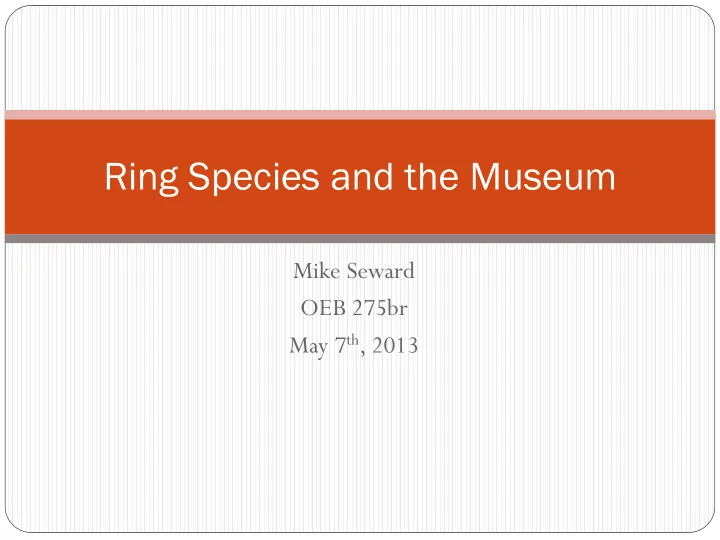

Ring Species and the Museum Mike Seward OEB 275br May 7 th , 2013
Biological Species Concept (BSC) Definition: a species is a group of interbreeding natural populations that are reproductively isolated from other such groups.
Ring Species Ring species are a connected series of neighboring populations, each of which can interbreed with adjacent populations, but where at least two “end” populations are too distantly related to interbreed. Challenges the BSC because there can be gene flow through the ring to these “end” populations despite being reproductively isolated.
Examples of Ring Species There are only a few confirmed ring species including the: Ensatina eschscholtzii salamander in California (a) Phylloscopus trochiloides greenish warbler in Asia (b) Larus gull in the Arctic circle (c) Euphorbia tithymaloides plant in Central America.
Phylloscopus trochiloides greenish warbler
Ensatina eschscholtzii salamander
Online Genetic Databases GenBank will provide genomic information that we can then examine using software programs.
GenBank IDs Sample ID Population Lat Long GenBank 202330 croc 35.04722 -118.48598 L75796 195607 croc 34.65289 -119.02541 L75797 172480 plat c 39.037 -120.9075 JN022615 225030 plat c 39.01371 -120.33931 JN022616 172459 oreg b 38.9064 -120.6445 L75813 CM165 oreg b 40.90261 -123.58649 JN022617 CM166 oreg b 40.90261 -123.58649 JN022618 CM167 oreg b 40.90261 -123.58649 JN022619 CM168 oreg b 40.90261 -123.58649 JN022620 CM171 oreg b 40.90261 -123.58649 JN022621
BatchGeo to select samples
FASTA format with BatchEntrez >GenBankID: L75811, gene=cytb AAAATTCACCCTTTATTAAAAATCATTAATAACTCCTTCATTGATTTA CCCACTCCATCAAATTTATCTTATTTATGAAACTTTGGATCACTACT AGGAATCTGTTTAGTTTCACAAATTCTTACTGGCCTTTTTCTAGCA ATACATTATACAGCAGATACCACCTCTGCATTCTCATCAGTTGTACA TATTTGCCGCGATGTGAATTACGGGTGAGTTTTACGAAATATTCAT GCCAACGGAGCCTCATTTTTTTTTATCTGTATTTATTTACATATTGG ACGAGGTATATATTATGGATCCTATATATTTAAAGAAACTTGAAATAT TGGAGTAATATTATTATTTTTTGTAATAGCAACAGCATTTGTAGGTTA TGTTCTTCCATGAGGACAAATATCATTCTGAGGCGCCACAGTTATC ACAAACCTCTTGTCAGCAATCCCATATATAGGAGATACACTAGTTCA ATGAATTTGGGGAGGCTTTTCAGTAGATAAAGCAACCCTTACCCGA TTTTTTGCTTTTCATTTTATTCTACCATTTATTGTAATGGGAGTTAG CATTATTCACTTATTATTTCTGCATGAAACCGGCTCCAATAATCCAA CAGGACTTTATTCTAATACAGATAAAATTTCATTCCACCCATACTTC TCATATAAAGACTTATTTGGATTT
SeaView Alignment
SeaView Alignment Statistics 52 species 519 selected sites including 518 complete (no gaps, no N) including 137 variable (26.4% of complete) including 49 informative (9.5% of complete) BASE COMPOSITION : All sites : 36.9% A 38.4% C 12.2% G 12.4% T Complete sites only : Minimum Maximum: A : 37.0 % 36.5% (AF316189) 40.3% (DQ453513) C : 38.3 % 37.8% (AF316171) 39.2% (DQ453513) G : 12.3 % 8.9% (DQ453513) 12.7% (AF316189) T : 12.4 % 11.6% (DQ453513) 13.1% (AF316171) OBSERVED CHANGES (complete sites) Transition/transversion ratio : 6.837 (mean over all sequence pairs) Minimum : 0.000 (AF316220 - AF316234, 0 transitions, 1 transversions) Maximum : 25.000 (AF316208 - AF316284, 25 transitions, 1 transversions)
Making the Trees PhyML Visualize with FigTree
Rooting the Trees Use the NCBI Blast tool to find similar sequences list >500 to get out of species Warbler Zebra finch ND6 Salamander Pigmy salamander cytb
Salamander oregonesis klauberi croceater platensis oregonesis platensis -oregonesis -platensis oregonesis picta oregonesis eschscholtzii xanthoptica Pigmy salamander
GenGIS-salamander Combining digital map data with phylogenetic trees
2D cladogram
Warbler Smallest # of transitions ludlowi viridanus plumbeitarsus ludlowi nitidus trochiloides plumbeitarsus obscuratus
MCZBase at Harvard Fortunately, we have 89 warblers at Harvard (Yes!!) Some are over 100 years old!
Morphology Wing length Beak length Body length
ImageJ- How to Quantify an Image Use ImageJ to measure the eyebrow area, a highly variable warbler trait.
Batch Geo: Warbler Skins
Morphology Averages: 5 per location Bill length Body Length 7.5 115.0 112.0 110.0 7.0 108.2 7.0 107.7 6.8 105.0 6.5 6.2 100.0 100.3 6.0 5.9 95.0 5.5 90.0 5.0 Burigoalni Sandakphu Tchegan-Burazi Yunnan Burigoalni Sandakphu Tchegan-Burazi Pass Yunnan Pass Eyebrow Area Wing Length 20.0 64.0 63.1 15.8 62.0 15.0 13.2 60.3 60.0 11.9 10.0 58.8 58.0 57.2 5.0 4.5 56.0 54.0 0.0 Burigoalni Sandakphu Tchegan-Burazi Yunnan Burigoalni Sandakphu Tchegan-Burazi Yunnan Pass Pass Burigoalni : Bangladesh Tchegan-Burazi Pass : Russia Sandakphu : India Yunnan : China
ANOVA: Analysis of Variance Body length and Variable P-Value wing length are Bill length .000 not statistically significant Wing Length .196 Bill length and Body Length .101 eyebrow are statistically Eyebrow Area .001 significant
ANOVA morphological results • Conclude that Bangladesh is more similar to China than to Russia. This makes sense on the map A: Bangladesh D: China C-Russia Note: We cannot distinguish the group from India.
Closing the ring between the museum and genomic studies Thank you!!
Recommend
More recommend